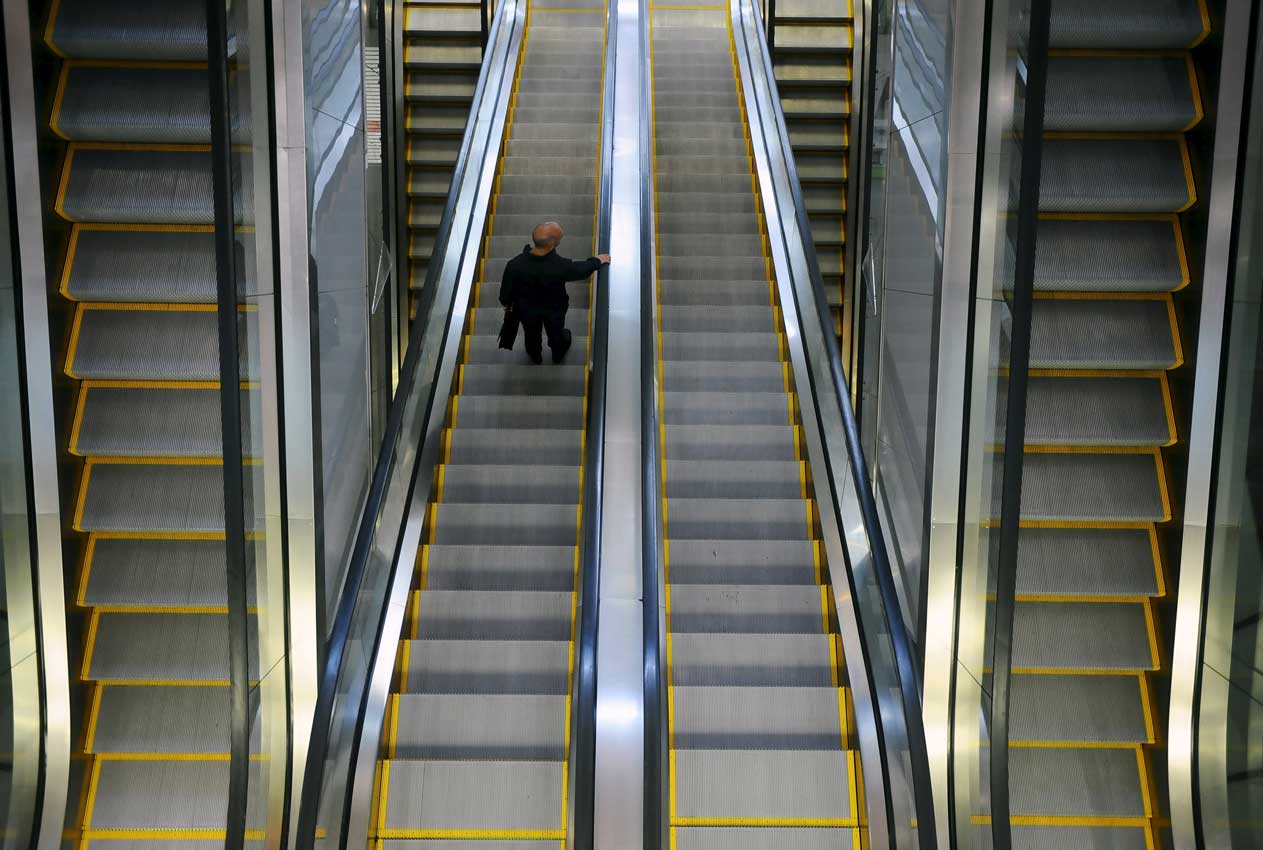They will run at current average speed at peak hours but slow down during off-peak hours
The Land Transport Authority (LTA) and transport operator SMRT plan to lower the speeds of escalators at train stations, following a recommendation to slow down these escalators to make it safer for senior citizens.
LTA told The Sunday Times on Friday that escalators at stations along the North-South and East- West lines will eventually run at two speeds – at 0.75m per second during peak hours, and a slower speed of 0.5m per second during off-peak hours. Now, the average speed of escalators at train stations here is 0.75m per second.
The dual-speed feature will be implemented during the escalator refurbishment programme, which starts this month. The works will be completed on 233 escalators at 42 of the 54 stations along the two lines by 2021. The feature will be extended, progressively, to station escalators for the North-East, Circle and Downtown lines, said LTA.
The upcoming Thomson-East Coast Line, which is opening in stages from 2019, will also have escalators running at these two speeds.
On Aug 1, a Public Transport Council report was released with recommendations to make rides more comfortable and less daunting for everyone, including families, seniors and wheelchair users. It had sought the views of more than 2,500 commuters.
One of the report’s key recommendations was the reduction of escalator speeds at train stations, to give peace of mind to senior citizens who might be intimidated by fast-moving escalators.
SMRT said it has been testing out slower escalator speeds at selected stations since July last year. Replying to queries from The Sunday Times, it said trials were conducted as part of efforts to improve travel experience. SMRT is “evaluating the possibility of reducing the speed of escalators at more MRT stations”.
This is on the back of positive feedback on the trial from commuters, who said they felt safer on slower escalators, it said.
However, SMRT did not reveal how many stations were involved in the trials and their locations.
LTA said it has been studying the issue of escalator speeds “for some time”. “We have worked with SMRT to trial reduced escalator speeds at selected stations.”
It said the current escalator speed is comparable to that adopted by overseas rail systems such as Hong Kong’s Mass Transit Railway and the London Underground. Generally, escalators at train stations move slightly faster than those elsewhere, to facilitate commuter flow.
Transport experts said there are benefits in reducing escalator speeds. It would ensure the safety of groups such as the elderly and the young, said Dr Lee Der Horng, a transport researcher at the National University of Singapore (NUS).
Dr Park Byung Joon, senior lecturer in urban transport management at SIM University, explained that speed is a factor in falls on automated moving walkways. “In South Korea, different train lines can be 500m to 600m apart. For this, commuters tend to take travellators. And during peak hours, one or two people will fall at the end,” he said.
LTA said that from January to May this year, the number of escalator-related incidents at MRT stations here “remained low” at 0.15 incident per one million riders, while the numbers for 2014 and 2015 were 0.15 and 0.14 respectively.
But there might be some drawbacks to having slower escalators.
“The escalators can now clear fewer people in the same span of time,” said Dr Park. But this is not an issue as long as escalator speeds are not slowed during peak hours.
Dr Lee said it is more appropriate to slow down escalators only at certain stations. “For example, there are hospitals at Novena and Outram and, hence, more elderly people (at stations there),” he said.
Several commuters welcomed slower escalators. Said retiree Xie Li Hua, 69: “It is dangerous for elderly people to take the escalators alone. Because of the speed, we might not be able to grab the handrail when getting on. If we fall while on the escalator, we will tumble all the way down.”
Mr Zachary Foo, 23, who takes the train to work in the Marina Bay Financial Centre from his home in Sengkang, said the dual-speed feature is a “good middle-ground solution”. “It is a good way to not affect the general flow of things, and also allay the fears of people falling on escalators,” said the law firm intern.
Mr Sitoh Yih Pin, chairman of the Government Parliamentary Committee for Transport, said the move “would improve overall safety for passengers at train stations”, and make stations “more user-friendly for the elderly and young children”.
fabkoh@sph.com.sg
Welcome move because of the speed, we might not be able to grab the handrail when getting on. If we fall while on the escalator, we will tumble all the way down. ” – RETIREE XIE LI HUA, 69
BE SELECTIVE
There are hospitals at Novena and Outram and, hence, more elderly people (at stations there). ” DR LEE DER HORNG, a transport researcher at the National University of Singapore, saying that it is more appropriate to slow down escalators only at certain stations.

This article was first published on Aug 7, 2016.
Get a copy of The Straits Times or go to straitstimes.com for more stories.










































